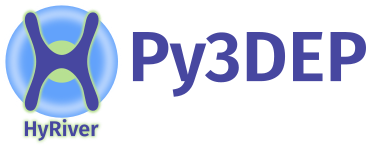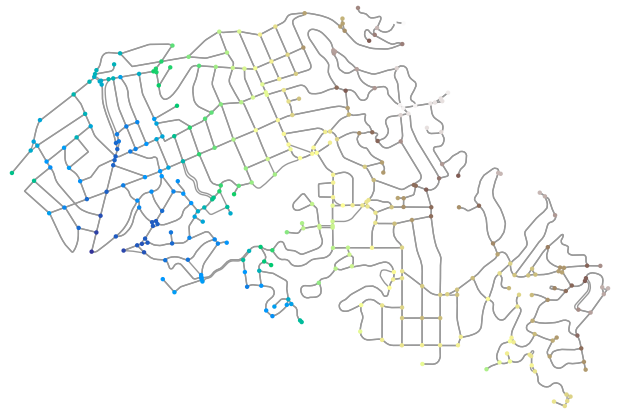Access USGS 3DEP database and get data such as elevation in the US
Project description


Package |
Description |
Status |
|---|---|---|
Navigate and subset NHDPlus (MR and HR) using web services |
||
Access topographic data through National Map’s 3DEP web service |
||
Access NWIS, NID, WQP, HCDN 2009, NLCD, and SSEBop databases |
||
Access Daymet for daily climate data both single pixel and gridded |
||
High-level API for asynchronous requests with persistent caching |
||
Send queries to any ArcGIS RESTful-, WMS-, and WFS-based services |
||
Convert responses from PyGeoOGC’s supported web services to datasets |
Py3DEP: Topographic data through 3DEP









Features
Py3DEP is a part of HyRiver software stack that is designed to aid in watershed analysis through web services. This package provides access to the 3DEP database which is a part of the National Map services. The 3DEP service has multi-resolution sources and depending on the user provided resolution, the data is resampled on the server-side based on all the available data sources. Py3DEP returns the requests as xarray dataset. Moreover, under-the-hood, this package uses requests-cache for persistent caching that can improve the performance significantly. The 3DEP web service includes the following layers:
DEM
Hillshade Gray
Aspect Degrees
Aspect Map
GreyHillshade Elevation Fill
Hillshade Multidirectional
Slope Map
Slope Degrees
Hillshade Elevation Tinted
Height Ellipsoidal
Contour 25
Contour Smoothed 25
Moreover, Py3DEP offers some additional utilities:
elevation_bygrid: For getting elevations of all the grid points in a 2D grid.
elevation_bycoords: For getting elevation of a list of x and y coordinates.
deg2mpm: For converting slope dataset from degree to meter per meter.
You can try using Py3DEP without installing it on you system by clicking on the binder badge below the Py3DEP banner. A Jupyter notebook instance with the stack pre-installed will be launched in your web browser and you can start coding!
Please note that since this project is in early development stages, while the provided functionalities should be stable, changes in APIs are possible in new releases. But we appreciate it if you give this project a try and provide feedback. Contributions are most welcome.
Moreover, requests for additional functionalities can be submitted via issue tracker.
Installation
You can install Py3DEP using pip after installing libgdal on your system (for example, in Ubuntu run sudo apt install libgdal-dev). Moreover, Py3DEP has an optional dependency for using persistent caching, requests-cache. We highly recommend to install this package as it can significantly speedup send/receive queries. You don’t have to change anything in your code, since Py3DEP under-the-hood looks for requests-cache and if available, it will automatically use persistent caching:
$ pip install py3depAlternatively, Py3DEP can be installed from the conda-forge repository using Conda:
$ conda install -c conda-forge py3depQuick start
You can use Py3DEP using command-line or as a Python library. The commanda-line provides access to two functionality:
Getting topographic data: You must create a geopandas.GeoDataFrame that contains the geometries of the target locations. This dataframe must have at least three columns: id, res, and geometry. The id column is used as filenames for saving the obtained topographic data to a NetCDF (.nc) file. The res column must be the target resolution in meter. Then, you must save the dataframe to a file with extensions such as .shp or .gpkg (whatever that geopandas.read_file can read).
Getting elevation: You must create a pandas.DataFrame that contains coordinates of the target locations. This dataframe must have at least two columns: x and y. The elevations are obtained using airmap service in meters. The data are saved as a csv file with the same filename as the input file with an _elevation appended, e.g., coords_elevation.csv.
$ py3dep --help
Usage: py3dep [OPTIONS] COMMAND [ARGS]...
Command-line interface for Py3DEP.
Options:
-h, --help Show this message and exit.
Commands:
coords Retrieve topographic data for a list of coordinates.
geometry Retrieve topographic data within geometries.The coords sub-command is as follows:
$ py3dep coords -h
Usage: py3dep coords [OPTIONS] FPATH
Retrieve topographic data for a list of coordinates.
FPATH: Path to a csv file with two columns named ``lon`` and ``lat``.
Examples:
$ cat coords.csv
lon,lat
-122.2493328,37.8122894
$ py3dep coords coords.csv -q airmap -s topo_dir
Options:
-q, --query_source [airmap|tnm]
Source of the elevation data.
-s, --save_dir PATH Path to a directory to save the requested
files. Extension for the outputs is either
`.nc` for geometry or `.csv` for coords.
-h, --help Show this message and exit.And, the geometry sub-command is as follows:
$ py3dep geometry -h
Usage: py3dep geometry [OPTIONS] FPATH
Retrieve topographic data within geometries.
FPATH: Path to a shapefile (.shp) or geopackage (.gpkg) file.
This file must have three columns and contain a ``crs`` attribute:
- ``id``: Feature identifiers that py3dep uses as the output netcdf/csv filenames.
- ``res``: Target resolution in meters.
- ``geometry``: A Polygon or MultiPloygon.
Examples:
$ py3dep geometry ny_geom.gpkg -l "Slope Map" -l DEM -s topo_dir
Options:
-l, --layers [DEM|Hillshade Gray|Aspect Degrees|Aspect Map|GreyHillshade_elevationFill|Hillshade Multidirectional|Slope Map|Slope Degrees|Hillshade Elevation Tinted|Height Ellipsoidal|Contour 25|Contour Smoothed 25]
Target topographic data layers
-s, --save_dir PATH Path to a directory to save the requested
files.Extension for the outputs is either
`.nc` for geometry or `.csv` for coords.
-h, --help Show this message and exit.Now, let’s see how we can use Py3DEP as a library.
Py3DEP accepts Shapely’s Polygon or a bounding box (a tuple of length four) as an input geometry. We can use PyNHD to get a watershed’s geometry, then use it to get the DEM and slope in meters/meters from Py3DEP using get_map function.
The get_map has a resolution argument that sets the target resolution in meters. Note that the highest available resolution throughout the CONUS is about 10 m, though higher resolutions are available in limited parts of the US. Note that the input geometry can be in any valid spatial reference (geo_crs argument). The crs argument, however, is limited to CRS:84, EPSG:4326, and EPSG:3857 since 3DEP only supports these spatial references.
import py3dep
from pynhd import NLDI
geom = NLDI().get_basins("01031500").geometry[0]
dem = py3dep.get_map("DEM", geom, resolution=30, geo_crs="epsg:4326", crs="epsg:3857")
slope = py3dep.get_map("Slope Degrees", geom, resolution=30)
slope = py3dep.deg2mpm(slope)
We can use rioxarray package to save the obtained dataset as a raster file:
import rioxarray
dem.rio.to_raster("dem_01031500.tif")Moreover, we can get the elevations of set of x- and y- coordinates on a grid. For example, let’s get the minimum temperature data within this watershed from Daymet using PyDaymet then add the elevation as a new variable to the dataset:
import pydaymet as daymet
import xarray as xr
import numpy as np
clm = daymet.get_bygeom(geometry, ("2005-01-01", "2005-01-31"), variables="tmin")
elev = py3dep.elevation_bygrid(clm.x.values, clm.y.values, clm.crs, clm.res[0] * 1000)
attrs = clm.attrs
clm = xr.merge([clm, elev])
clm["elevation"] = clm.elevation.where(~np.isnan(clm.isel(time=0).tmin), drop=True)
clm.attrs.update(attrs)Now, let’s get street network data using osmnx package and add elevation data for its nodes using elevation_bycoords function.
import osmnx as ox
G = ox.graph_from_place("Piedmont, California, USA", network_type="drive")
x, y = nx.get_node_attributes(G, "x").values(), nx.get_node_attributes(G, "y").values()
elevation = py3dep.elevation_bycoords(zip(x, y), crs="epsg:4326")
nx.set_node_attributes(G, dict(zip(G.nodes(), elevation)), "elevation")
Contributing
Contributions are very welcomed. Please read CONTRIBUTING.rst file for instructions.
Project details
Release history Release notifications | RSS feed
Download files
Download the file for your platform. If you're not sure which to choose, learn more about installing packages.


















